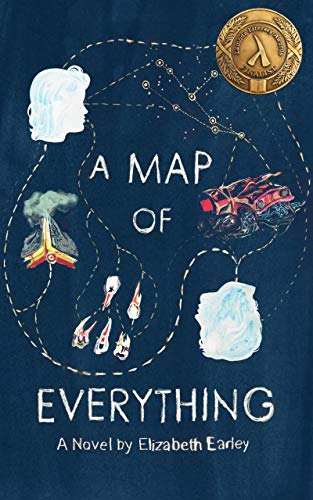A Map of Everything
Elizabeth Earley

Anne’s journey includes periods of intense turmoil and escapism, punctuated by experiences of love, success, and coming to terms with her identity as an addict. Over the course of the novel, Anne also begins to understand and accept another important aspect of herself; her identity as the sister of the pre-accident June, and her continuing relationship with the June who emerged from her coma a deeply changed person. This culminates in Anne taking her mother, oldest sister Lee, and June on a family vacation to Paris, a trip June was meant to take twenty years earlier with her French class, before her accident. In the Paris vignettes, Earley starkly illustrates the obstacles that many able-bodied people easily navigate, but which for June and her family require monumental preparation and planning. Through these scenes the characters are witness to both their own frustrations and achievements, as well as those of each other.
One refreshing aspect of this book is that Anne appears to have little or no difficulty inhabiting her queer identity. From the onset she seems clear in her desire to be involved with women, and there is a notable absence of the expected “coming out” story in which she doubts herself or is thrown into crisis when sexuality and expectations collide; her family makes little issue of her choice of partners. As such, while large sections of the novel revolve around Anne’s relationships with other women, her queerness is incorporated seamlessly and the focus of the story remains the family’s orbit around June and her accident.
The novel is raw, brave, and explicit; Earley delves into potent subject matter without batting an eye at the details, which she embeds in such a way as to make her work ring with truth and familiarity. Occasionally the narrator’s torment reads like a therapy-session transcript and might be better served by cutting down on the lengthy monologues in which each detail of a feeling or event is dissected, but for the most part the close, almost claustrophobic confessional style enables the reader to become intimately acquainted with what might otherwise be an inaccessible family portrait.
In contrast to the brash verbosity of the prose, Christa Donner’s visual art is often quiet, simple, and understated, though it frequently deals in images that evoke aspects of the body, such as disembodied limbs, silhouetted faces, and abstractions that could be teeth or a spine. Her pieces are interspersed in a manner and proportion that does not detract from the writing, but rather glides alongside Earley’s words, adding a parallel breath and rhythm.
Overall, A Map of Everything it is a thoughtful and deeply intimate portrait, crafted with energy, compassion, and a reverence for the experiences that shape individuals and families. ~ Theodosia Henney
Check for it on:
Details
| ISBN | 9781937543440 |
| Genre | Fiction |
| Publication Date | Dec-13 |
| Publisher | Jaded Ibis Press |
| Format | Paperback |
| No. of Pages | 285 |
| Notes | Lambda Literary Award Finalist, Debut Fiction |
| Language | English |
| Rating | Good |
| Illustrator | Christa Donner |
| BookID | 95 |

